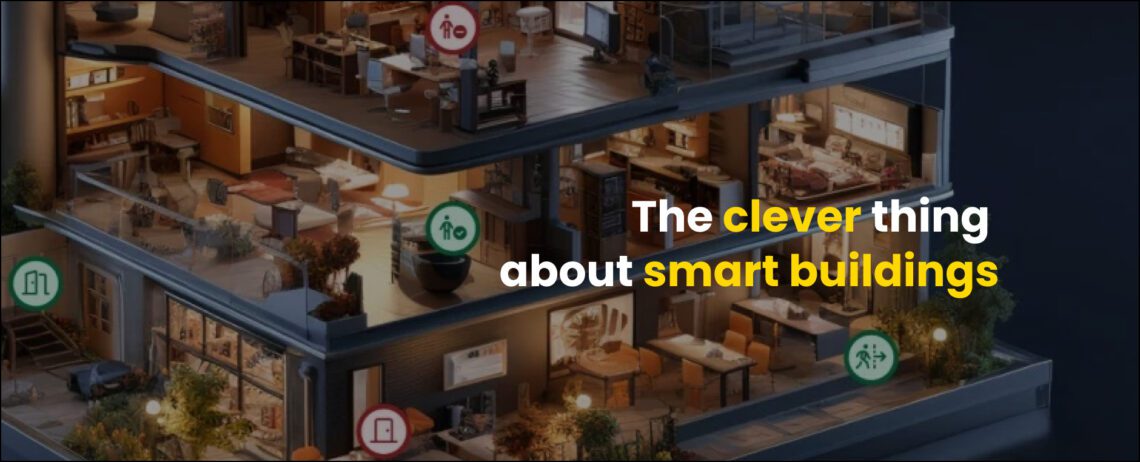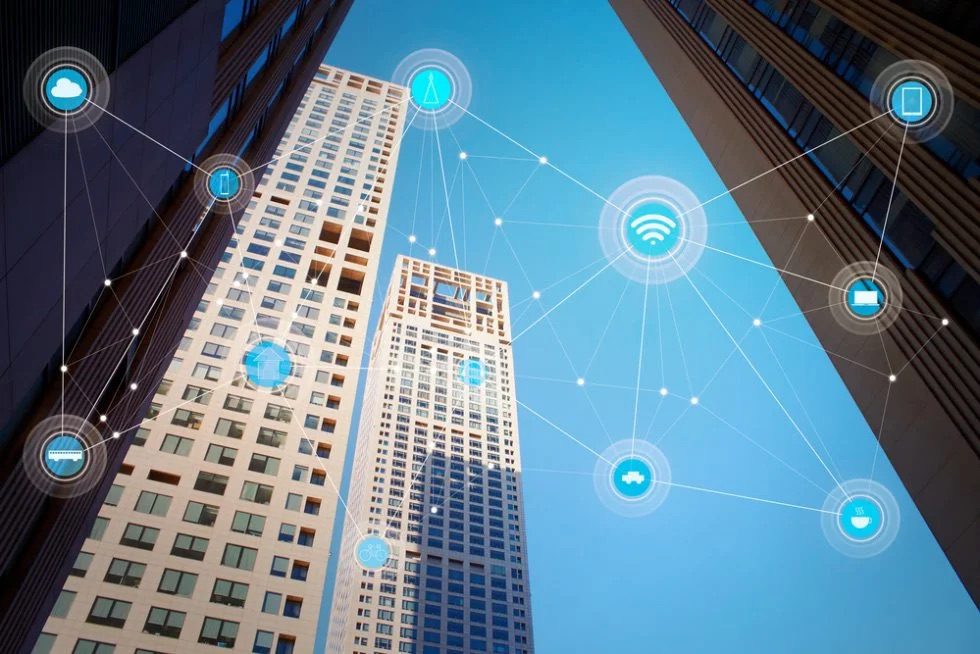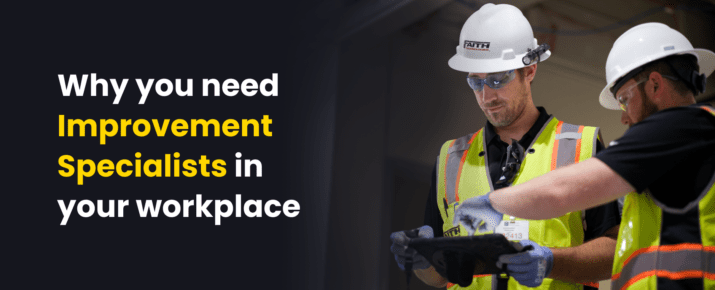The clever role of IoT in smart buildings
World Of Work | By | 7 Feb 2024 | 4 minute read

ICYMI, Internet of Things (IoT) technology has transformed the way we run our homes (Why get up from the couch to switch on the lights when you can ask Alexa to do it for you?). Now, IoT is fast making its mark on the smart-building industry. The number of buildings using smart IoT solutions will grow from 45 million in 2022 to 115 million in 2026 – and with rapid growth comes endless opportunities.
SafetyCulture and IoT software company Inauro have been exploring IoT building management, weaving purpose-built connectivity solutions into the fabric of our flagship Sydney office. This setup works as a demo landscape for our valuable customers, showcasing all the useful – and cool – things an IoT-enabled building can do.
But, as with any IoT solution, there are benefits and challenges. Let’s unpack them.
What is IoT in building management?
IoT technology connects physical devices and sensors to the internet, allowing people to analyze and act on data in real-time. IoT can monitor and control various aspects of the building’s operations in smart buildings via a data fusion platform. Not sure what that means? Let’s use our Sydney office to paint a clearer picture.

Delivering smart IoT solutions
In our Sydney office, Inauro has helped us solve essential business requirements. These include:
- Zone-detection sensors, which show heatmaps of which areas are in use and at which times.
- We’d often wondered how our outstanding kitchen crew was able to prepare just the right amount of lunch for SafetyCulture staff each day. Turns out there are ‘people counters’ at the entrances, which tell our kitchen staff how many people have turned up to work that day, which ultimately leads to reduced food wastage.
- Temperature alerts for our fridge and freezers to monitor food storage.
- Rather than cleaners doing the restroom rounds at specific times, door sensors tell them which ones have been frequently used and need cleaning – checks have gone from time-based to on-demand.
- Sometimes Friday after-work drinks on our rooftop can get a little ‘vocal’. Fitted noise sensors ensure staff remain compliant with local regulations, and minimize disturbance to our neighbors.
- Soil moisture sensors for our indoor plants trigger irrigation cycles, optimizing cleaning rosters, and green asset maintenance.
Inauro’s Chief Technology Officer, Mitch Hirsch, worked closely on the project and noted: “These solutions have one thing in common; they take the guesswork and human-induced delays out of the equation, and ultimately, the building runs itself.”

“[This technology] takes the guesswork and human-induced delays out of the equation, and ultimately, the building runs itself.”
– Mitch Hirsch, Chief Technology Officer, Inauro
The benefits of IoT building management
As with any IoT solution, smart buildings can be customized. These benefits can include:
Improved building energy efficiency and sustainability
- Smart thermostats can learn the preferences and habits of users to set optimal temperatures for each room.
- Smart lighting systems turn off the lights when no one is around.
- Smart meters can provide real-time feedback on energy usage and costs.
Reduced maintenance costs with predictive maintenance
- Smart sensors can measure the vibration, temperature, and pressure of the heating, ventilation and air-conditioning (HVAC) system and alert any sign of damage or malfunction.
- Smart sensors can also monitor the structural health of the building, including cracks, corrosion, or moisture, preventing potential hazards.
Real-time HVAC system monitoring ensures optimal performance and prevents costly breakdowns.
Smart sensors can track key parameters such as temperature, pressure, and vibration, detecting potential issues before they arise.
For those interested in developing expertise in this area, Miller-Motte College offers an HVAC & Basic Refrigeration Training program. Learn the essential skills needed to maintain these vital systems and start your journey in a field driven by IoT advancements.
According to a report by Deloitte, predictive maintenance can increase productivity by 25%, reduce breakdowns by 70%, and lower maintenance costs by 25%. It’s the way of the future!
Optimized use of space
- Smart cameras and motion sensors can display the availability of meeting rooms, desks, or parking spaces on a dashboard or mobile app.
Did you know? Inauro powers the technology behind SafetyCulture Sensors. Learn about how you can protect your assets and business with our sensors.
Enhanced tenant security, comfort, and safety
- Smart locks and biometric scanners can provide secure and convenient access to the building and prevent unauthorized entry.
- Smart cameras and alarms can monitor the building’s perimeter and interior and detect any suspicious activity or emergency.
- AI voice assistants are transforming the hospitality industry by powering smart speakers that provide information, entertainment, and hands-free control of a building’s devices and systems.
- Smart smoke detectors and sprinklers can detect and respond to fire incidents, alerting the fire brigade and building occupants.
As with most digital solutions, smart buildings will also have challenges. One of the most crucial is ensuring a reliable data flow.
Mitch explains: “In buildings, there always are connectivity black spots, and ground knowledge is key. In the first few days of deploying people-counting solutions for SafetyCulture, we noticed our counters weren’t returning to zero at the end of each day. Was the count inaccurate? Were people staying overnight? There weren’t many, but enough to raise the question. After investigating, we discovered some employees commonly accessed an emergency exit door that shouldn’t have been used.”

The future of IoT-enabled buildings
With 5G networks advancing, and more complex and sophisticated IoT applications evolving, we can expect to see a surge in smart buildings IoT. A report by Markets and Markets predicts the global smart building market will reach over USD $121.6 billion by 2026.
As the IoT market matures, there will be an increased need for regulation to ensure the quality, compatibility, and security of devices and solutions.
Mitch advises: “With companies looking to bring employees back to work after the COVID-19 pandemic, we need to prioritize dynamic and engaging workplaces. Regulation will shortly follow, and we can already see certifications like WELL taking the forefront in building validations.”
Originally published by Inauro and adapted with permission.
Read more:
- How this donut company went from reactive to proactive using our Sensors
- Check out our Sydney HQ office (video)
- Frontline workers are excited about AI
Important Notice
The information contained in this article is general in nature and you should consider whether the information is appropriate to your specific needs. Legal and other matters referred to in this article are based on our interpretation of laws existing at the time and should not be relied on in place of professional advice. We are not responsible for the content of any site owned by a third party that may be linked to this article. SafetyCulture disclaims all liability (except for any liability which by law cannot be excluded) for any error, inaccuracy, or omission from the information contained in this article, any site linked to this article, and any loss or damage suffered by any person directly or indirectly through relying on this information.





